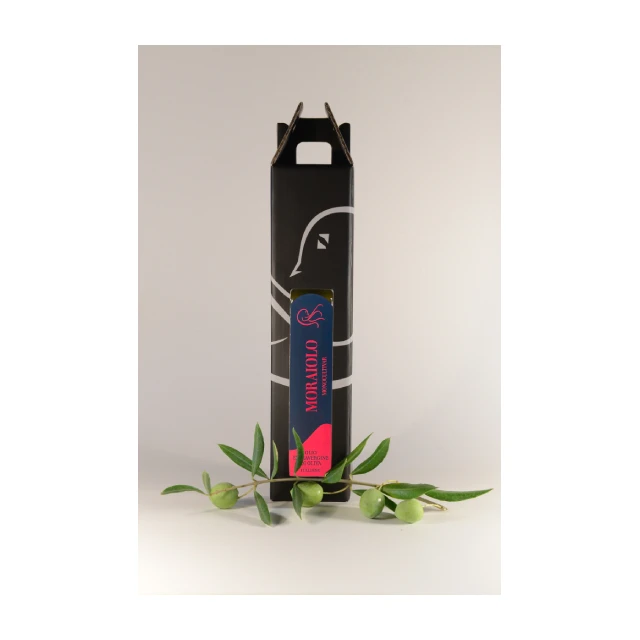Итальянское высококачественное монокультиваторное оливковое масло Moraiolo с
- Категория: Оливковое масло >>>
- Поставщик: AZ.AGR.,PASSO,DELLA,PALOMBA,DI,ALESSADRO,GILOTTI
Поделиться:
Описание и отзывы
Трекер стоимости
| Месяц | Минимальная цена | Макс. стоимость |
|---|---|---|
| Sep-16-2025 | 0.9 $* | 0.75 $* |
| Aug-16-2025 | 0.33 $* | 0.0 $* |
| Jul-16-2025 | 0.66 $* | 0.72 $* |
| Jun-16-2025 | 0.92 $* | 0.71 $* |
| May-16-2025 | 0.68 $* | 0.92 $* |
| Apr-16-2025 | 0.14 $* | 0.92 $* |
| Mar-16-2025 | 0.72 $* | 0.69 $* |
| Feb-16-2025 | 0.63 $* | 0.97 $* |
| Jan-16-2025 | 0.6 $* | 0.1 $* |
Характеристики

Product Description

Moraiolo Monocultivar
Extra Virgin Olive Oil obtained from olives Moraiolo grown in the hills of Todi. Early harvested (first ten days of October)
pressed the same day in the company two-stage oil mill and immediately filtered. Bottled under nitrogen to ensure maximum shelf
life, thus achieving a high quality product, rich in aromas and intense flavours with very low acidity and peroxide and very high
in polyphenols (extremely beneficial to the health). Passo della Palomba Moraiolo has been selected as "Slow Food" Presidium .
Moraiolo Monocultivar is an Extra Virgin Olive Oil of great organoleptic value almost exciting in his bright green with gold gleams. Bouquet ample and fragrant, with aromas of green tomatoes, Artichoke leaf, unripe almonds, spinach and chicory. Coherent and balanced taste, with pleasant almond feelings and intense aromatic correspondence. Complex ending. Long closure, pleasantly
spicy and bitter. Excellent with food rich in flavour requiring a strong robust oil like grilled meat, legumes soups and various kind of Italian pasta.

Specification
item | value |
Type | OLIVE OIL |
Product Type | Fruit Oil |
Grade | EXTRA VIRGIN |
Processing Type | Cold Pressed |
Packaging | Glass Bottle |
Purity (%) | 100 |
Volume (L) | 0.50 |
Place of Origin | Italy |
Brand Name | Passo della Palomba |
Model Number | Moraiolo Monocultivar |
Use | Season |
Color | bright green with gold gleams |
Storage | 0,50 Liter dark ad heavy glass bottle with antifraud cap and Nitrogen |
Taste | Coherent and balanced |
Pairing | grilled meat, legumes soups and various kind of Italian pasta |
Region of Production | Italy |
Company Profile
Passo della Palomba
A taste of paradise countryside.
In this wonderful complex of the early nineteenth century, expertly restored and brought back to life, you can immerse yourself in pristine silence, enlivened only by the sounds of the woods and forget "real life",
the city and work for a few days.
In these magnificent shaded hills populated by ancient olive groves, the Gilotti family has brought back to its former glory a property in which it was dedicated to viticulture and olive growing.
The story is in the name of this place, which derives from the "palombe" or "wild pigeons", which pass through this precise area during their incredible journey that takes them every year from North Europe to Africa in early October.
This charming property is located on the hills at about 3Km from Todi, in the locality of Cecanibbi so called for a station created here by the army of Hannibal, already without one eye, during the military expedition that would have led him to clash with the Roman army.
The beauty of this locality, its position and the presence of numerous specimens of falcon, also suggests another origin of the name: the kite, a bird used in falconry techniques, which was hooded before the hunt.
The property, abandoned for decades, was now falling into ruin while still showing its ancient beauty, when Alessandro and Claudia Gilotti, together with their children Stefano and Luca saw it for the first time: it was love at first sight.
The palomba also inspires the brand that the Gilotti family wanted to give to this fascinating place: a head of a dog turned towards one side as if to observe and guard the place.
A skilful "philological" restoration based on the reuse of everything that could be recovered, without distorting the site, has allowed, after about four years of intense work, to restore "the soul" to the farmhouses that open their gaze to nature, dominating a panorama of unparalleled harmony, beauty and charm and, at the same time, to express all the love that the Gilotti family has for these places.
The olive groves surround the property degrading from top to bottom as if to caress the soft hills; In the area of the olive grove that lies on the hill overlooking the houses of the Passo della Palomba estate, there are interesting terraced olive groves built with ancient skill using the techniques of dry stone walls.
The terracing had the aim of containing the steep terrain and creating large flat areas where to cultivate the olive trees. These are fascinating constructions that still testify today to the ingenuity of man and his struggle for survival.
The terraces are very useful for the cultivation of the olive tree because they allow the seedlings to take more sun and drain the rainwater well and thus improve the quality of the olives.
The term "dry stone" indicates how the elements that make up the retaining wall are arranged close to each other without the use of mortar that acts as a binder.
The walls made in this way can have variable heights depending on the slope of the slopes on which they are built and equally variable lengths depending not only on the characteristics of the slopes, but also on the parceling of the territory. Generally at the base of the wall, which is very wide, a flat area (foot) is created that can be walked easily, thus giving the opportunity to take interesting walks along the walls or take care of the majestic olive trees during the various phenolic phases of the plant. In the Passo della Palomba estate there are beautiful examples of such ancient artifacts. The walls generally have an inward slope and the section is tapered.
This shape serves to improve soil containment.
If you look carefully you are amazed and wonder how such large boulders could have been arranged at those heights at the time when excavators and other lifting machines were certainly not available.




There are six oils produced: two blends: Olistico (Moraiolo, Frantoio, Leccino, the three typical cultivars) ad Olistico Gran Cru a “special reserve” (Moraiolo Frantoio Leccino Dolce Agogia Don Carlo) and 5 Monocultivars of great organoleptic depth Moraiolo, Leccino, Frantoio, Don Carlo and Dolce Agogia.
State of the art technology and processes are used to produce these unique products that over the years distinguished themselves in many national and international competition.



Certifications


Awards



Contacts

Località Boschetto 47, Cecanibbi
06059 Todi - PG - Italy
Tel. +39.3351051401
info@passodellapalomba.com












